The fuel pressure regulator is an important part of the fuel delivery system. Its job is to regulate the fuel pressure in the fuel system in response to engine requirements.
The symptoms of a bad fuel pressure regulator include poor fuel economy, difficulty starting the engine, fuel in the vacuum lines and engine misfires.
If your car won’t always start or is running rough, then a bad fuel pressure regulator may be the problem.
9 Symptoms Of A Bad Fuel Pressure Regulator
A bad fuel pressure regulator often causes the same symptoms as a rich mixture condition.
This is because when the fuel pressure regulator diaphragm is broken, fuel passes through it all the way through to the vacuum line and ultimately reaches the intake manifold.
Here are some of the most common signs of a bad fuel pressure regulator.
1. Check Engine Light on the dashboard
The check engine light will usually come on if the ECU records an error in one of the critical engine circuits.
If there are problems with the fuel system, this will be picked up by the ECU and logged in memory. If you run a diagnostic you can expect to find error code P0089.
You can also expect the check engine light to start flashing after a few driving cycles if your car has a bad fuel pressure regulator. This is due to the rich mixture condition caused by the bad fuel pressure regulator.
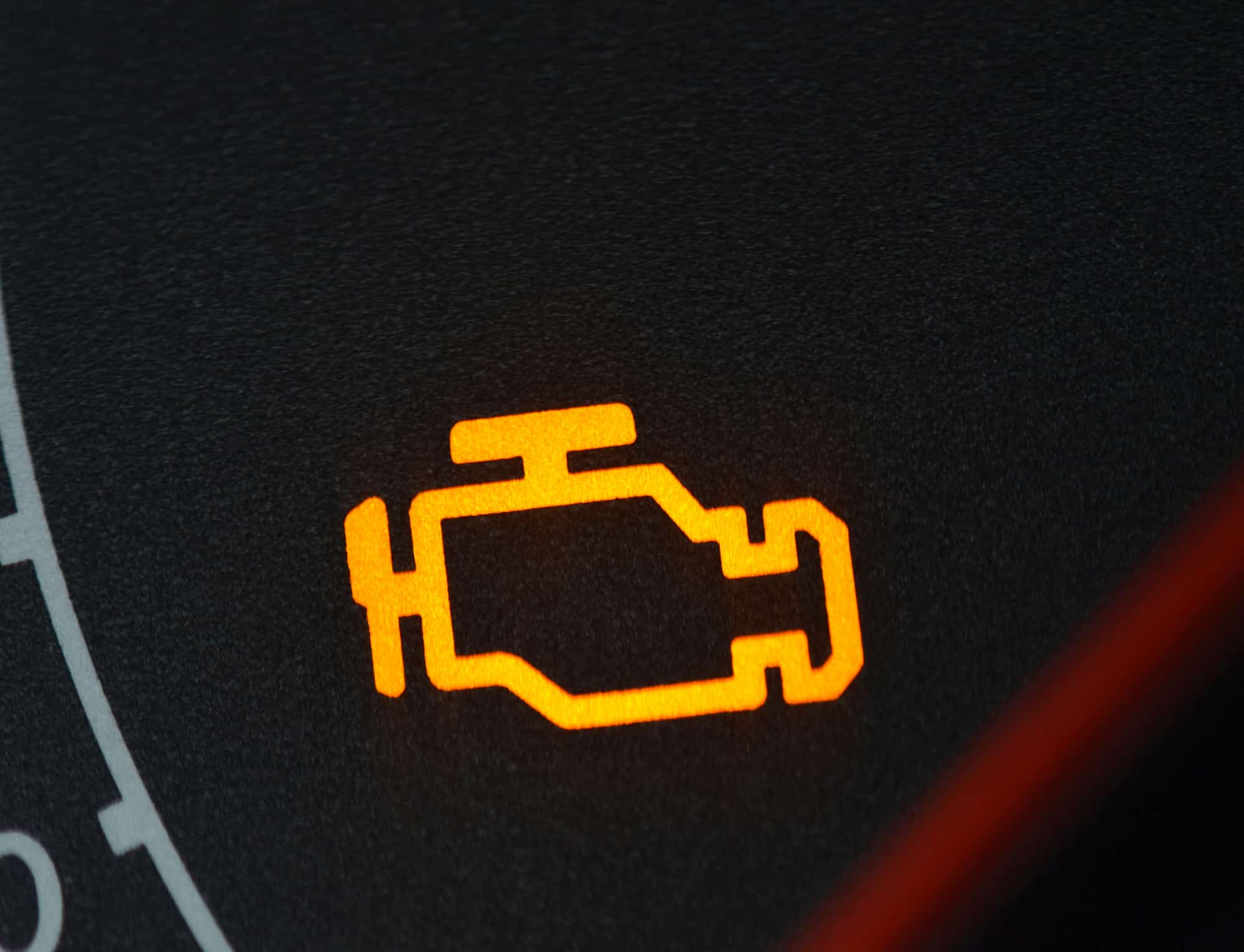
2. Difficulty during engine start (especially when hot)
A bad fuel pressure regulator can create a difficult to start or ‘no start’ engine.
If the ECU can’t measure the excess fuel coming through the fuel pressure regulator vacuum line, it will usually cause the engine to run rich (too much fuel). As a result, some of this fuel will find its way to the intake manifold, causing a build up of fuel deposits. When the engine is hot, this can make it harder to start the engine.
3. Poor fuel economy
A bad fuel pressure regulator can also cause poor fuel economy.
If the ECU can’t keep track of the amount of fuel going through the fuel pressure regulator, it’s going to result in lower fuel economy.
The fuel pressure regulator controls the fuel pressure in the fuel system in response to engine demand. It does this by opening and closing the fuel return valve. If too much fuel remains when not needed, then this will lead to poor economy. As you may expect, this problem will increase fuel consumption dramatically.
4. Fuel in the vacuum lines
A broken fuel pressure regulator can result in fuel in the vacuum lines.
The fuel pressure regulator is directly connected to the engine vacuum. Fuel leaked through this line will spread to the vacuum system and can eventually lead to other problems such as cracking or splitting of rubber vacuum hoses.
5. Possible engine misfires
Another very common symptom of fuel pressure regulator failure is engine misfires.
If the fuel pressure regulator is not managing the fuel pressure properly, this can result in the engine running rich or lean.
The incorrect fuel delivery may cause intermittent engine misfires depending on the fuel demands of the engine.
It’s worth noting that engine misfires can also be caused by a wide range of other problems such as bad fuel injectors or a bad fuel filter to name but a few.
6. Rough Engine idle and hesitation
Another sign of problems with the fuel delivery system and the fuel pressure regulator, is a rough engine idle accompanied by jerking or hesitation when stopped.
If the fuel pressure regulator cannot properly regulate the fuel pressure, it can cause the engine to run badly. When an engine is idling, the vacuum pressure can be as low as 10psi, but there is a vacuum in the intake manifold.
The fuel pressure regulator must adjust and lower the fuel pressure in the fuel rail to match the effective pressure of the intake manifold to stop fuel from being sucked back from the injectors, and to keep the engine running when idling.
It’s also possible for a rough engine idle to be caused by a stuck or failing idle air control valve.
7. Back-fire during Deceleration
A failed fuel pressure regulator can contribute to engine back fire when decelerating.
Fuel particles won’t burn in the combustion chamber and will enter the exhaust pipe with a high energy charge. This energy is then unleashed in the form of mini explosions.
8. Gas smell from exhaust pipe
The failure to deliver the exact amount of fuel to the engine could cause a noticeable gas smell coming from your exhaust pipe. You may also anticipate problems with the spark plugs, black smoke, and even gasoline dripping from the exhaust tail when the condition is severe.
9. Potential destruction of the catalytic converter
One of the worst problems caused by a bad fuel pressure regulator is the potential destruction of the catalytic converter. The fuel particles reaching the catalyst system will corrode it at very high speed, literally “melting it” and making it useless.
What Is A Fuel Pressure Regulator?
The fuel pressure regulator (also known as an FPR) is a vacuum controlled valve that is usually located on the fuel injectors rail. A simplification of an FPR would be imaging it as a device that controls the amount of fuel returning to the fuel tank.
Its job is to ensure that adequate fuel pressure is being delivered to the fuel injectors under any situation. In order to fully understand its relevance, you must keep in mind two key phrases: “adequate fuel pressure” and “under any situation”.
There’re driving situations that dramatically affect fuel pressure requirements, most notably, wide open throttle (WOT) acceleration and sudden deceleration (closed throttle).
The first one, WOT acceleration, demands all available power from your engine immediately.
The Electronic Control Unit (ECU) will do everything at hand to fulfil that demand. This includes increasing the fuel injectors pulse duration to its maximum value. Doing so could cause a drop in the fuel injectors rail pressure and thus a huge lag in performance.
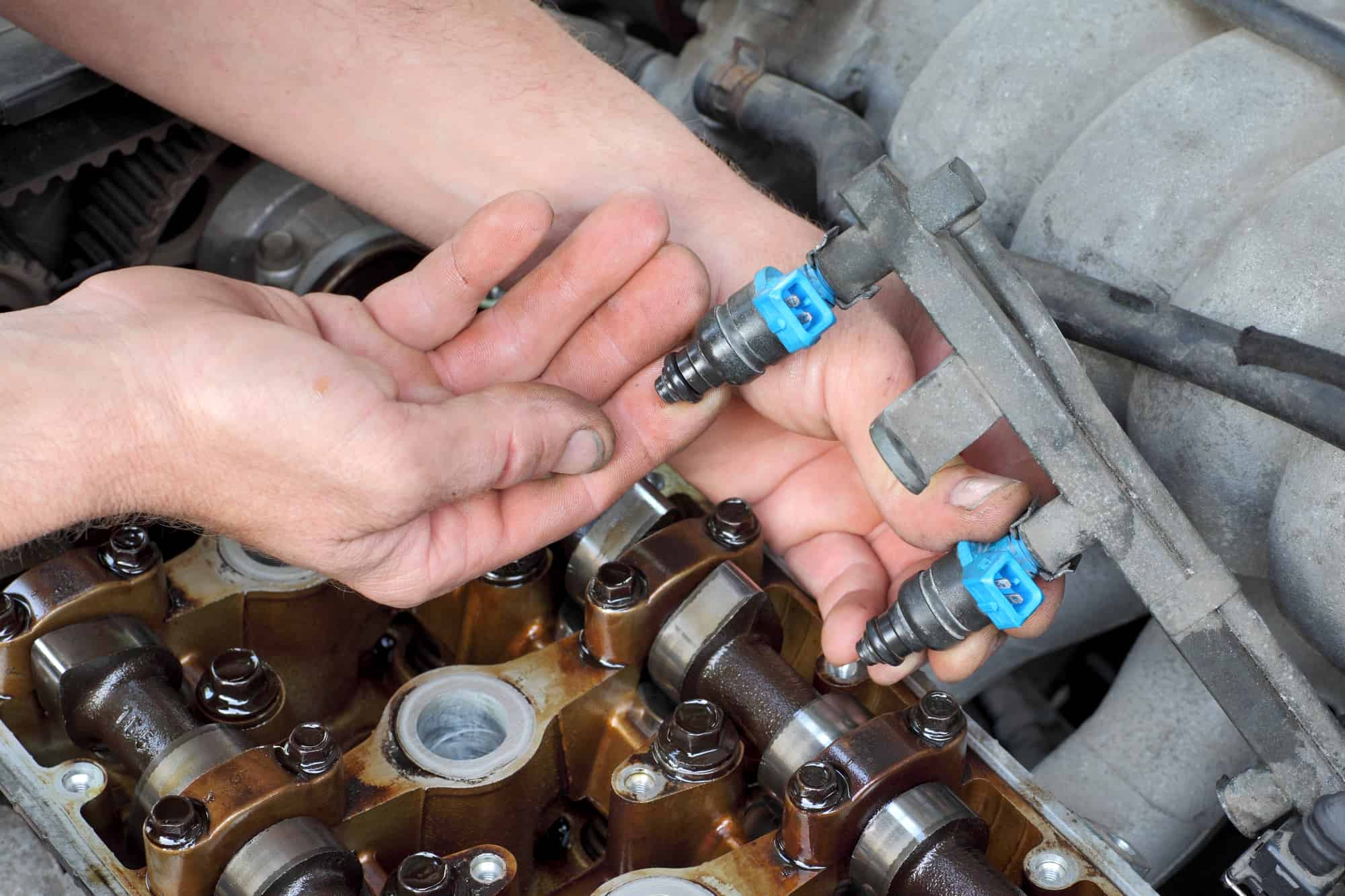
Some typical injectors in an engine
The fuel pressure regulator prevents such a situation by means of partially blocking the fuel return line which in turn preserves the adequate pressure.
The second scenario, sudden deceleration, is just the contrary. The ECU may entirely shut-off the fuel injectors which could cause an overpressure in the fuel rail. In that case, the FPR allows the excess fuel return to the fuel tank and thus the normal pressure is preserved.
How Does A Fuel Pressure Regulator Work?
Internally, the fuel pressure regulator consists of a diaphragm that is attached on one side to a spring and on the other side to a ball-type valve. The spring side is exposed to the engine vacuum while the valve side is connected in one end to the fuel injector rail (fuel inlet) and the other to the return line (fuel outlet).
Under normal conditions (engine off), the spring forces the diaphragm downwards, almost closing the valve. When the engine starts the vacuum side of the FPR forces the diaphragm upwards opening the valve and letting fuel return to the tank. The spring is calibrated in a way that the fuel pressure in the rail is enough for fuel injectors normal demand.
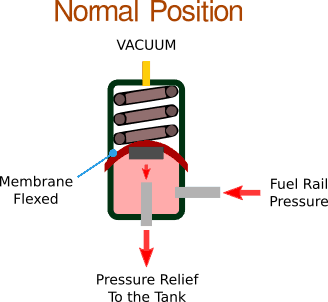
When a wide open throttle condition as described above occurs, the engine briefly loses its vacuum which allows the spring to force the diaphragm downward closing the return line and thus incrementing the fuel available for the injectors.
Under deceleration, the vacuum increases forcing the diaphragm upwards and opening the valve more than normal, dropping the pressure in the fuel rail to a minimum.
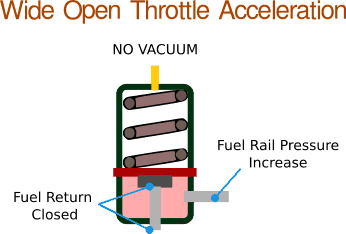
The fuel pressure regulator design described above is the more widely used. It’s very simple and reliable, but not infallible. It can be subject to wear, especially the diaphragm that is constantly moving up and down.
How Do You Diagnose A Bad Fuel Pressure Regulator?
For the purpose of this article, it’s assumed that you have a basic knowledge of safety precautions while working on your vehicle.
You may need one or more of the following tools:
- OBD2 Code Reader
- Fuel pressure gauge with proper adapters.
- Vacuum gauge with proper adapters.
- Manual vacuum pump with proper adapters.
Always refer to the appropriate OEM literature when possible. Original manufacturer diagnostic procedures should always have precedence over a generic workflow.
1. Preliminary steps
Recommended tools: OBD2 Code Reader / automotive scan tool
> Data trouble codes: using an OBD2 code reader take note of any DTC present in the ECU memory. For doing so you only need to connect your code reader and turn the ignition key on (engine off), a state usually known as KOEO.
> Data trouble codes clear: now that you know what codes were stored into memory you need to clear them. This is usually done selecting “clear codes” in your tool.
2. Visual Inspection
Recommended tools: none
> Vacuum line: disconnect the fuel pressure regulator vacuum line and perform a visual inspection of its condition. Look for signs of worn or deterioration. Pay special attention to possible holes in the vacuum line. Ideally, a vacuum line test using a manual vacuum pump should be performed.
> Fuel Pressure Regulator inspection: disconnect the vacuum line and observe any gasoline drip coming from the regulator. If you observe any indication of gasoline in the regulator or in its vacuum line then you should replace the piece.
Fix any wiring problem before continuing.
3. Vacuum Tests
Recommended tools: vacuum gauge, manual vacuum pump.
> Engine vacuum: using the appropriate adapter connect the vacuum gauge and start your engine. Compare the vacuum value with the OEM literature and check is within the accepted range. A low engine compression, intake air leak, or a bad engine timing could cause a low vacuum and hence the fuel pressure will be higher than normal.
> Fuel Pressure Regulator condition: using the appropriate adapter connect the manual vacuum pump to the FPR. Apply vacuum by the order of 25-30 in-Hg. Watch for any gasoline drip in the FPR vacuum connection. Replace the fuel pressure regulator if necessary.
> Fuel Pressure Regulator functional test: using the appropriate adapter connect the manual vacuum pump to the FPR. Apply vacuum by the order of 17 in-Hg. Connect the fuel pressure gauge using the appropriate adapter. Start the engine and take note of the fuel pressure at idle. Now watch at the fuel gauge while incrementing the vacuum applied to the FPR. The fuel pressure should drop as you increase the vacuum. Most vacuum pumps have a trigger button to release the vacuum. Watch carefully the fuel gauge while releasing the vacuum. The pressure should go up and stay that way. Take note of all fuel pressure readings and compare them with the OEM literature. Replace the FPR if necessary.
How To Replace A Bad Fuel Pressure Regulator
The FPR sensor is usually located in the fuel injector rail.
Recommended tools: OBD2 Code Reader, safety glasses, mechanics gloves, appropriate screwdriver and/or wrench, proper illumination (LED flashlight),
> Preliminary steps: ensure that the ignition switch is off and then disconnect the vehicle battery. Detaching the negative terminal is usually enough.
> Remove FPR sensor vacuum line: disconnect the fuel pressure regulator vacuum line, replace the line if you notice excessive wear.
> Release fuel pressure from the system: most engines have a fuel pressure test port. Connect your fuel pressure gauge and use its bypass valve to release the pressure. An alternative method is using a screwdriver to relief the pressure tapping the test port. Be careful if you plan to do so, modern vehicles use high-pressure systems, safety goggles are highly recommended.
> Remove FPR screws: most fuel pressure regulators are attached to the fuel rail using screws, but depending on your vehicle other tools may be necessary. Carefully remove the regulator pushing it out ot the fuel rail. Be warned that many vehicles require removing the whole fuel rail in order to access the FPR screws. Don’t forget to replace the regulator o-ring if it not included with the new FPR.
> Install the new FPR sensor: retire the old FPR and then install the new one. Double check that you’re using the adequate part number.
> Reconnect the vacuum lines and battery: once you are done, reconnect the vacuum lines and then the battery terminal.
> Clear DTC memory: using the OBD2 code reader clear the ECU memory to prevent any false code been stored. You will need entering in KOEO mode for doing so.
> Perform driving cycle: once you are done, drive the vehicle for more than 10 minutes. Try to accelerate as you would normally do.
As an Amazon Associate we earn from qualifying purchases.


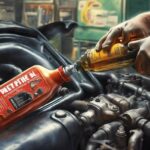




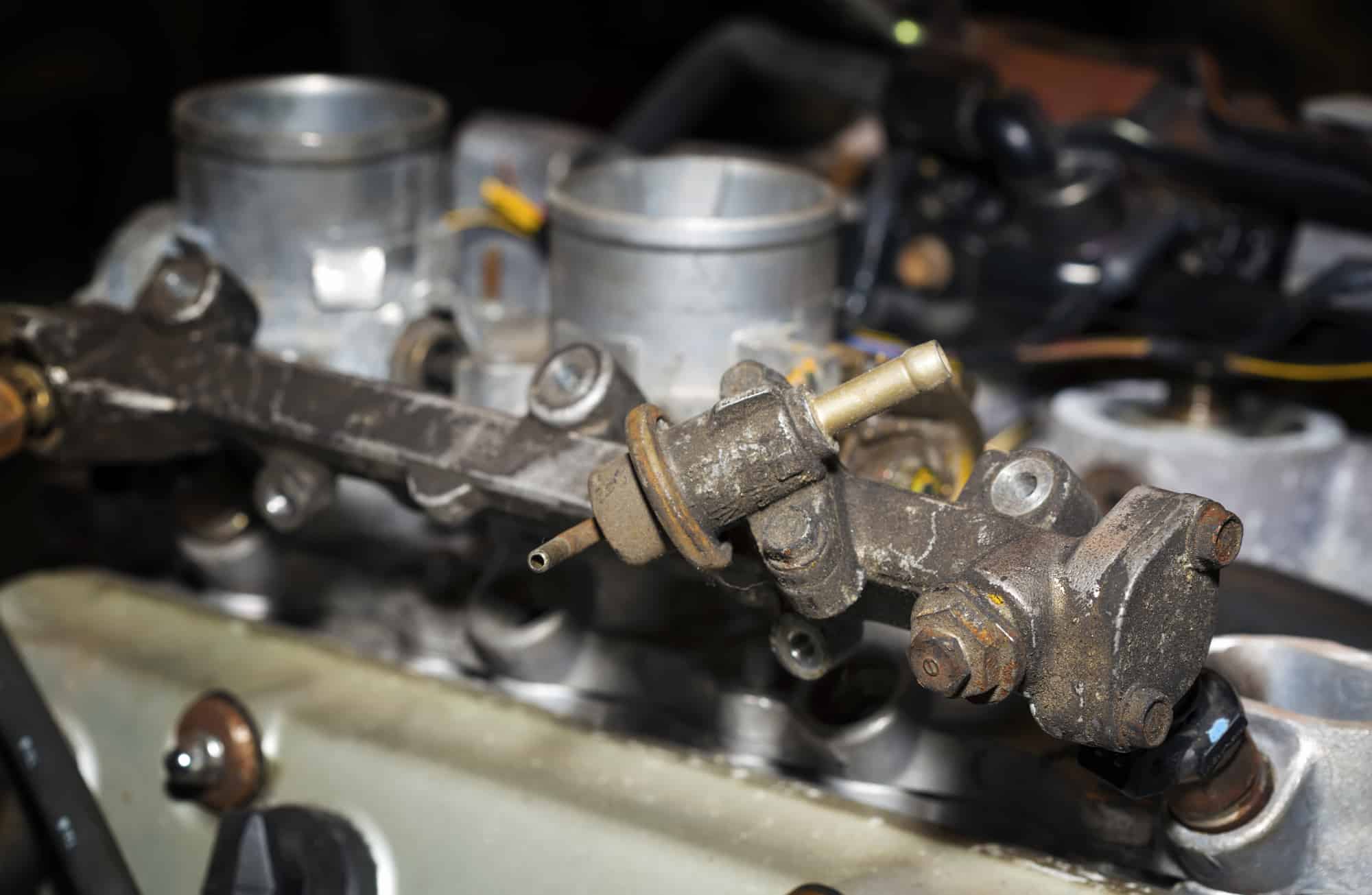

How do I properly diagnose a bad fuel pressure regulator without access to advanced diagnostic tools?
Lately, my car has been having difficulty starting, especially when the engine is hot, and I’ve noticed a significant decrease in fuel economy. Could these issues be symptoms of a bad fuel pressure regulator?